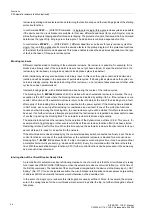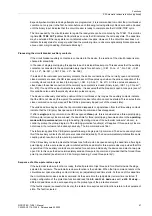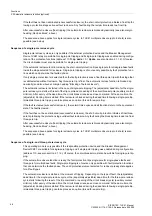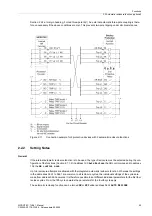
Functions
2.1 General
SIPROTEC, 7VK61, Manual
C53000-G1176-C159-3, Release date 05.2009
40
2.1.6
Oscillographic Fault Records
The 7VK61 breaker management relay features a fault memory. The instantaneous values of measured values
i
L1
, i
L2
, i
L3
, i
E
and u
L1
, u
L2
, u
L3
, u
4
(voltages depending on the connection) are sampled at intervals of 1 ms (for 50 Hz) and stored in a circulating
buffer (20 samples per cycle). For a fault, the data are stored for an adjustable period of time, but no more than
5 seconds per fault. A total of 8 faults can be saved during a total time of 15s. The fault record memory is au-
tomatically updated with every new fault, so that no acknowledgment is required. The storage of fault values
can be started by pickup of a protective function, as well as via binary input and via the serial interface.
2.1.6.1
Description
The data can be retrieved via the serial interfaces by means of a personal computer and evaluated with the
operating software DIGSI and the graphic analysis software SIGRA 4. The latter graphically represents the data
recorded during the system fault and calculates additional information such as the impedance or r.m.s. values
from the measured values. A selection may be made as to whether the currents and voltages are represented
as primary or secondary values. Binary signal traces (marks) of particular events, e.g. „fault detection“, „trip-
ping“ are also represented.
If the device has a serial system interface, the fault recording data can be passed on to a central device via this
interface. Data are evaluated by appropriate programs in the central device. Currents and voltages are referred
to their maximum values, scaled to their rated values and prepared for graphic presentation. Binary signal
traces (marks) of particular events e.g. „fault detection“, „tripping“ are also represented.
In the event of transfer to a central device, the request for data transfer can be executed automatically and can
be selected to take place after each fault detection by the protection, or only after a trip.
2.1.6.2
Setting Notes
General
Other settings pertaining to fault recording (waveform capture) are found in the submenu
Oscillographic Fault
Records
submenu of the
Settings
menu. Waveform capture makes a distinction between the trigger instant
for an oscillographic record and the criterion to save the record (address
402
WAVEFORMTRIGGER
). This pa-
rameter can only be altered using DIGSI at
Additional Settings
. Normally the trigger instant is the device
pickup, i.e. the pickup of an arbitrary protective function is assigned the time. The criterion for saving may be
both the device pickup (
Save w. Pickup
) or the device trip (
Save w. TRIP
). A trip command issued by the
device can also be used as trigger instant (
Start w. TRIP
), in this case it is also the saving criterion.
An oscillographic fault record includes data recorded prior to the time of trigger, and data after the dropout of
the recording criterion. Usually this is also the extent of a fault recording (address
403
WAVEFORM DATA
=
Fault event
). If automatic reclosure is implemented, the entire system disturbance — possibly with several
reclose attempts — up to the ultimate fault clearance can be stored (address
403
WAVEFORM DATA
=
Pow.Sys.Flt.
). This facilitates the representation of the entire system fault history, but also consumes
storage capacity during the auto reclosure dead time(s). This parameter can only be altered with DIGSI under
Additional Settings
.
The actual storage time begins at the pre-fault time
PRE. TRIG. TIME
(address
411
) ahead of the reference
instant, and ends at the post-fault time
POST REC. TIME
(address
412
) after the storage criterion has reset.
The maximum recording duration to each fault
MAX. LENGTH
is set at address
410
.
The fault recording can also be triggered via a binary input, via the keypad on the front of the device or with a
PC via the operation or service interface. The storage is then dynamically triggered. The length of the fault re-
cording is set in address
415
BinIn CAPT.TIME
(maximum length however is
MAX. LENGTH
, address
410
).
Summary of Contents for Siprotec 7VK61
Page 8: ...Preface SIPROTEC 7VK61 Manual C53000 G1176 C159 3 Release date 05 2009 8 ...
Page 14: ...Contents SIPROTEC 7VK61 Manual C53000 G1176 C159 3 Release date 05 2009 14 ...
Page 316: ...Literature SIPROTEC 7VK61 Manual C53000 G1176 C159 3 Release date 05 2009 316 ...
Page 328: ...Glossary SIPROTEC 7VK61 Manual C53000 G1176 C159 3 Release date 05 2009 328 ...
















































